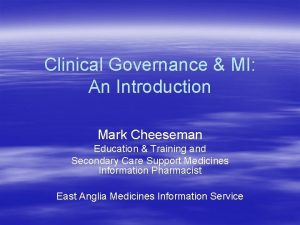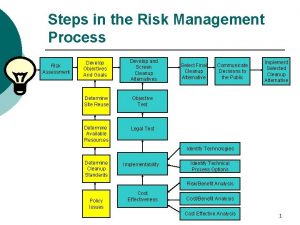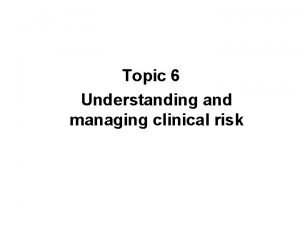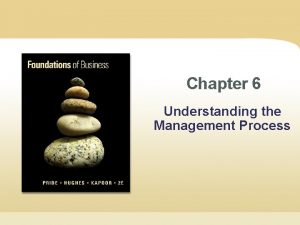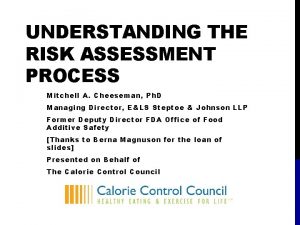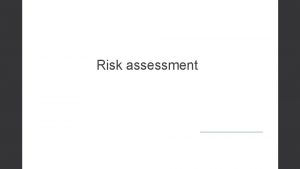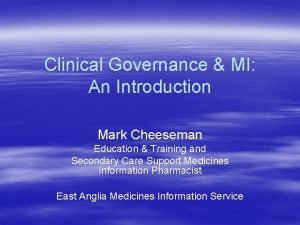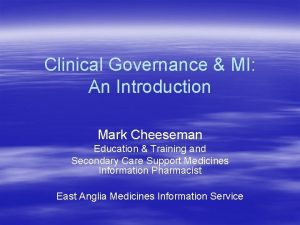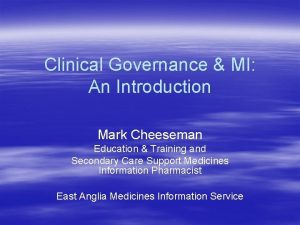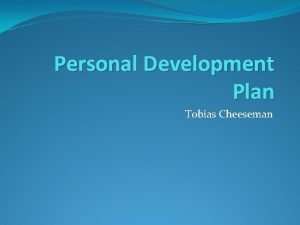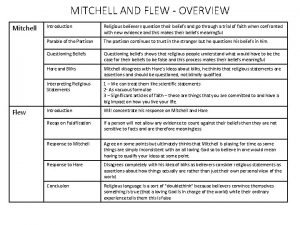UNDERSTANDING THE RISK ASSESSMENT PROCESS Mitchell A Cheeseman






























- Slides: 30

UNDERSTANDING THE RISK ASSESSMENT PROCESS Mitchell A. Cheeseman, Ph. D Managing Director, E&LS Steptoe & Johnson LLP Former Deputy Director FDA Office of Food Additive Safety [Thanks to Berna Magnuson for the loan of slides] Presented on Behalf of The Calorie Control Council

Risk Assessment for All Chemicals Natural or Synthetic Risk Hazard (Potential to cause harm) Exposure

Risk Hazard Exposure Expo sure

RISK ASSESSMENT OF FOOD ADDITIVES • Evaluated for safety by an independent scientific body before being approved for use in the given market; • International = JECFA • Joint Food Additives Organization/World Health Organization Expert Committee on Food Additives; • European = EFSA, the European Food Safety Authority; • United States = FDA, U. S. Food & Drug Administration; • All establish the maximum exposure or ADI (Acceptable Daily Intake) based on hazard assessment to ensure all food additives pose low risk of harm.

Hazard (Potential to cause harm) Hazard is assessed by specific toxicology studies and the general knowledgebase. For additives to be used in food: • Short- and life-time toxicity studies in many species • Effects assessed during pregnancy and development May include human clinical studies. Objective: using studies with varying doses, determine Level that causes No Observed Adverse Effect over lifetime. NOAEL is a measure of hazard. Higher NOAEL = lower toxicity or hazard.

TOXICOLOGY STUDIES • Does the additive affect the genetic material? • Genetic toxicity (mutations); • Where does additive go when we consume it? Absorption, metabolism, distribution and excretion • What adverse effects does the additive cause? • At what dose do we see adverse effects? • Any effect on Reproduction? • during pregnancy, birth and development; • Human studies: • Only when shown safe in animals • Special populations.

NOAEL -from long-term studies -use most sensitive species and endpoint -highest dose that caused no adverse effect -mg/kg body weight/day No-Observed Adverse Effect Level (NOAEL) Lowest Observed Adverse Effect (LOAEL)

Estimate Acceptable Daily Intake (ADI) = amount ‘‘that can be ingested daily over a lifetime without appreciable health risk’’ (WHO 1987). Based on No-Observed Effect Level (NOAEL): Apply “safety factors” of 100 to account for • differences between individuals (10 X) • differences between humans and animals (10 X) NOAEL/safety factor = ADI (mg/kg/day) • For example: • If NOAEL= 4000 mg/kg/d, ADI = 40 mg/kg/d. • ADI is very conservative, based on level with no effect when fed to animals for life-time and divided by “safety factor” cushion.

ACCEPTABLE DAILY INTAKE 4000 mg/kg/d No observed effect level in lifetime studies 450 400 350 300 250 200 150 100 50 0 Amount considered safe to consume every day 40 mg/kg/d

ACCEPTABLE DAILY INTAKE • Based on the most sensitive critical health outcome in the most sensitive species; • Established to protect the most sensitive sub-population, including pregnant women and children; • ADI is intended to cover exposure of older infants and children, the fetus during pregnancy and the neonatal and young infant periods; • If there is scientific evidence that infants and children are more sensitive to an additive, that evidence must be used in derivation of ADI; • Based on body weight and adjusted for age and size; • Experts generally agree that special ADIs should not be established and that ADI must be safe for all subgroups.

SAFETY BUILT INTO EXPOSURE ESTIMATE • Assume all foods with approved uses have the maximum approved use levels of additive. • Determine intake of foods with approved use by highest consumers. • Includes children and other groups • Ensure no one has estimated intake higher than ADI.

Assess Exposure SOURCES OF DATA Disappearance data • Total production figures; amounts entering the national food chain. Where and how is food additive used • Categories listed in food standards legislation and advisory texts (eg. Codex General Standard for Food Additives); • Food industry usage surveys; • Food labeling surveys. Use levels • Maximum permitted levels in food standards legislation • Industry usage survey levels* • Analytical data* * Variability in data – range, ‘typical’, maximum?

Estimate Range/Distribution Assess Exposure of Human Intakes OCCURRENCE DATA: Data on the presence of a food additive in individual foods, including its fate during the processing. FOOD CONSUMPTION: Data on the consumption patterns of the individual foods containing the food additive. Individual exposure to additive Level of food additive in each food/ beverage Amount of food additive consumed Amount of each food/beverage consumed

Estimate Range/Distribution of Human Intakes • Exposure assessment is intended to cover the population, taking into account the variation in food consumption; • Across countries and between various groups of the population, in particular those considered sensitive such as children and the elderly. • Dietary surveys of food consumption used to assess intakes by different groups. • This process is highly conservative as usually the maximum permitted level in food is used together with the maximum amount of food consumed (worst case approach). http: //www. ilsi-guidea. org/index. php

RISK ASSESSMENT PARADIGM Identify Hazard Characterize Dose-Response Assess Exposure Estimate Acceptable Daily Intake (ADI) Estimate Range/Distribution of Human Intakes Characterize Risk What fraction of the population, if any, incurs intakes greater than the ADI? To what extent do intakes exceed the ADI? Food survey for target population

SWEETENERS AS AN EXAMPLE

IS THE SWEETENER MUTAGENIC? • Usually first toxicology studies to be conducted. • If determined to be genotoxic, no future studies conducted as the sweetener will not be approved • Assess the potential of a sweetener to induce DNA or chromosomal defects (somatic cell) or heritable defects (germ cell). • There are many types of tests to determine mutagenicity. • The most common battery tests include the Ames test for gene mutations in bacteria, in vitro tests and in vivo tests.

WHAT HAPPENS TO THE SWEETENER IN THE BODY? Pharmacokinetics (also called ADME) • Evaluates the rate and extent of: • Absorption (how much and where? ); • Distribution (does the sweetener accumulate in any tissues? ); • Metabolite formation (are any toxic? ); • Excretion of sweetener (how quickly? route? ).

WHAT HAPPENS TO THE SWEETENER IN THE BODY? Data from studies allows for an understanding of the following questions: • Does the animal used in the toxicology testing have similar ADME as humans? • How much variability is there between individuals? • Are there any potential susceptible subpopulations? • This is used to establish ADI. • Studies may also provide data on possible mechanisms or modes of toxicity at high concentrations.

DOES THE SWEETENER CAUSE ADVERSE EFFECTS? All compounds, both natural and man-made, will be toxic at some dose The goal is to establish a dose that is safe when consumed every day or at the No Observed Effect Level (NOEL) Extensive testing be conducted in animals, using a minimum of three doses, which are above the expected human exposure levels. Ideally, want: • • Low dose with no observed effect High dose that produces mild toxicity Mid-range doses to establish dose-response For non-toxic, high doses that are studied may be set at an accepted limit dose Short-term studies conducted to ensure no adverse effects and to establish doses before investing in long-term lifetime studies

DOES THE SWEETENER CAUSE CANCER? This usually requires a two-year study in rats plus an 18 -month study in mice with 20 -25 animals/sex per group and at least three dose levels plus a control groups. Any evidence of dose response in incidence of tumors, time of tumor development, tumors/animal, benign versus malignant, and site of tumor development. Must consider relevance to humans and background incidence. Studies that do not use the approved methods may not be valid for risk assessment.

DOES THE SWEETENER HAVE ANY EFFECT DURING REPRODUCTION, PREGNANCY AND DEVELOPMENT? Objective of testing is to determine potential adverse effects on conception, pregnancy, delivery, lactation, neonatal survival and vitality • Sweetener should be fed to parents before mating, to mother during pregnancy and lactation, then to subsequent generation. Measurements include: • • • Pup weight; Number of pregnancies that go to full-term; Lactation survival after 21 days; Development of offspring Necropsy and histopathology of parents with special attention to reproductive organs.

WORST-CASE ASSUMPTIONS FOR ASPARTAME EXPOSURE Distinction between products with and without added sugar was only possible for: flavoured drinks, confectionery and chewing gums. For other food groups, assumed all products are sweetened with aspartame at highest level permitted. • flavoured fermented milk products, edible ices, soups and broths, fruit nectars, desserts, jams and other fruit and vegetable preparations. • The majority of these products are sweetened with sugar. Low sugar varieties use other heat-stable low-calorie sweeteners. Result is very conservative exposure estimates, and significant over-estimation of aspartame use.

EXPOSURE ESTIMATE EXAMPLE: EFSA ESTIMATED ASPARTAME CONSUMPTION IN USERS ONLY Toddler Children Adolescent Adults 1. 6 -16. 3 1. 8 -12. 6 0. 8 -4. 0 0. 7 -8. 5 High level 7. 5 -36. 0 6. 3 -32. 4 2. 3 -13. 2 2. 4 -27. 5 Mean - Reported as mg/kg body weight/day. - Minimum-maximum across all 26 dietary surveys conducted in 17 different European countries; - Assumed that all processed foods contained aspartame at maximum permitted level or highest reported use level. - Compare to ADI of 40 mg/kg/d to ensure no group exceeding (EFSA 2013)

ACTUAL INTAKES 4000 No observed effect level in lifetime studies 450 400 350 300 250 200 150 100 ADI Highest user Average user 10 -15 mg/kg/d 2 -5 mg/kg/d 50 0 NOEL ADI Highest intake Average Intake

Exposure Intense sweetness = low levels of use Exposure ÷ 200 -300 Sugar Sweetness intensity of non-caloric sweetener

WHAT ARE THE CONSEQUENCES OF SWEETENER INTAKES ABOVE ADI? This question was investigated by an international expert panel (ILSI, 1998) • Depends on how much above the ADI • Depends for how often and how long. There is a often a large difference between the dose that showed no effects (NOAEL) and next higher dose tested that shows adverse effects. This difference corresponds to an extra safety factor in addition to that normally applied to a NOAEL. High level of conservatism is built into ADI so that there is low risk of harm from occasional intakes above the ADI in small amounts.

CONCLUSIONS • There is international harmonization on the approaches and methods used for safety assessment of food additives. • Toxicity testing requirements for food additives is extensive. • ADIs are established to protect the entire population and susceptible sub-populations are carefully considered. • Exposure assessments are very conservative and usually reflect worst case scenarios. • Use of food additives is not approved until all safety questions have been addressed and estimates of exposures have been determined to be below ADI for all populations.

REFERENCES AND RESOURCES EFSA. 2012. Guidance for submission for food additive evaluations. EFSA Journal; 10(7): 2760 ILSI Europe. 1998. Significance of Excursions of intake above the ADI. ILSI Europe. 1997. Applicability of the Acceptable Daily Intake (ADI) to infants and children. ILSI Europe. Dietary Exposurehttp: //www. ilsiguidea. org/index. php? title=Introduction_to_dietary_exposure_ass essment#General_principles_of_exposure_assessment JECFA. http: //whqlibdoc. who. int/trs/WHO_TRS_144. pdf WHO 2009. Environmental Health Criteria 240, Principles and Methods for the Risk Assessment of Chemicals in Food.

Thank you! Questions? mcheeseman@steptoe. com
 Mitchell cheeseman
Mitchell cheeseman Mitchell cheeseman
Mitchell cheeseman Market risk credit risk operational risk
Market risk credit risk operational risk Inti pati utama dasar cheeseman 1946
Inti pati utama dasar cheeseman 1946 Lambang perpaduan kaum 31 ogos 1970
Lambang perpaduan kaum 31 ogos 1970 Ordinan pelajaran koloni 1956
Ordinan pelajaran koloni 1956 Mark cheeseman
Mark cheeseman Dlc117: the risk management (rm) process
Dlc117: the risk management (rm) process Understanding and managing clinical risk
Understanding and managing clinical risk Chapter 6 understanding the management process
Chapter 6 understanding the management process Chapter 6 understanding the management process
Chapter 6 understanding the management process Knowledge process understanding
Knowledge process understanding Language experience approach example
Language experience approach example Risk projection in software engineering
Risk projection in software engineering Risk mitigation avoidance
Risk mitigation avoidance Absolute risk vs relative risk
Absolute risk vs relative risk Residual risk and secondary risk pmp
Residual risk and secondary risk pmp Inherent risks examples
Inherent risks examples Absolute risk vs relative risk
Absolute risk vs relative risk Activity sheet 1: conservative, moderate or speculative?
Activity sheet 1: conservative, moderate or speculative? Risk classification system
Risk classification system Risk financing transfer adalah
Risk financing transfer adalah The biggest risk is not taking any risk
The biggest risk is not taking any risk Key risk indicators for vendor management
Key risk indicators for vendor management Business risk vs audit risk
Business risk vs audit risk Business risk and financial risk leverage
Business risk and financial risk leverage Attributable risk formula
Attributable risk formula Risk map
Risk map Attributable risk (ar)
Attributable risk (ar) Hình ảnh bộ gõ cơ thể búng tay
Hình ảnh bộ gõ cơ thể búng tay Turbine banki cross-flow®
Turbine banki cross-flow®






